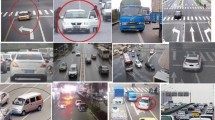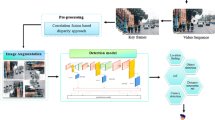Abstract
The detection of abnormal vehicle events is a research hotspot in the analysis of highway surveillance video. Because of the complex factors, which include different conditions of weather, illumination, noise and so on, vehicle’s feature extraction and abnormity detection become difficult. This paper proposes a Fast Constrained Delaunay Triangulation (FCDT) algorithm to replace complicated segmentation algorithms for multi-feature extraction. Based on the video frames segmented by FCDT, an improved algorithm is presented to estimate background self-adaptively. After the estimation, a multi-feature eigenvector is generated by Principal Component Analysis (PCA) in accordance with the static and motional features extracted through locating and tracking each vehicle. For abnormity detection, adaptive detection modeling of vehicle events (ADMVE) is presented, for which a semi-supervised Mixture of Gaussian Hidden Markov Model (MGHMM) is trained with the multi-feature eigenvectors from each video segment. The normal model is developed by supervised mode with manual labeling, and becomes more accurate via iterated adaptation. The abnormal models are trained through the adapted Bayesian learning with unsupervised mode. The paper also presents experiments using real video sequence to verify the proposed method.
Similar content being viewed by others
References
Sun Z H, Bebis G, Miller R. On-road vehicle detection: A review. IEEE T Pattern Anal, 2006, 28(5): 694–711
Giachetti A, Campani M, Torre V. The use of optical flow for road navigation. IEEE T Robotic Autom, 1998, 14(1): 34–48
Mallot H, Bulthoff H, Little J, et al. Inverse perspective mapping simplifies optical flow computation and obstacle detection. Biol Cybern, 1991, 64(3): 177–185
Ito T, Yamada K, Nishioka K. Understanding driving situations using a network model. In: Intelligent Vehicles’95 Symposium. Detroit: IEEE Computer Society, 1995. 48–53
Weng J N, Wu L, Huang J, et al. Efficient visualization techniques for high resolution remotely sensed data in a network environment. Sci China Series E-Tech Sci, 2008, 51(supp. 1): 124–134
Sheng H, Li C, Wei Q, Xiong Z. Real-time detection of Abnormal Vehicle Events with Multi-Feature over Highway Surveillance Video. In: ITSC. Beiing: IEEE Computer Society, 2008. 550–556
Bennett K P, Demiriz A. Semi-supervised support vector machines. Lect Notes Comput SC, 1998, 10: 368–374
Nigam K, McCallum A, Thrun S, et al. Text classification from labeled and unlabeled documents using EM. Mach Learn, 2000, 39(2–3): 103–134
Wu L X, Wang Y B, Shi W Z. Integral ear elimination and virtual point-based updating algorithms for constrained Delaunay TIN. Sci China Series E-Tech Sci, 2008, 51(supp. 1): 135–144
Stauffer C, Eric W, Grimson L. Learning patterns of activity using real-time tracking. IEEE T Pattern Anal, 2000, 22(8): 747–757
Xiang T, Gong S. Video behaviour profiling and abnormality detection without manual labeling. In: ICCV. Beijing: IEEE Computer Society, 2005. 2: 1238–1245
Bilmes J. A gentle Tutorial of the EM Algorithm and Its Application to Parameter Estimation for Gaussian Mixture and Hidden Markov Models. California: International Computer Science Institute, 1998
Reynolds D A, Quatieri T F, Dunn R B. Speaker verification using adapted Gaussian Mixture Models. Digit Signal Process, 2000, 10(1–3): 19–41
Zhang D, Daniel G, Samy B. Semi-supervised meeting event recognition with adapted HMMs. In: ICME. New York: IEEE Computer Society, 2005. 1102–1105
Gauvain J L, Lee C H. Maximum a posteriori estimation for multivariate gaussian mixture observation of markov chains. IEEE T Speech Audi P, 1994, 2: 291–298
Juang B H, Rabiner L R. The segmental K-means algorithm for estimating parameters of hidden Markov models. IEEE T Acoust Speech, 1990, 38(9): 1639–1641
Zhang D, Gatica-Perez D, Bengio S, et al. Semi-Supervised adapted HMMs for unusual event detection. In: CVPR. San Diego: IEEE Computer Society, 2005. 1: 611–618
Author information
Authors and Affiliations
Corresponding author
Additional information
Supported by the National Natural Science Foundation of China (Grant No. 60803120)
Rights and permissions
About this article
Cite this article
Sheng, H., Xiong, Z., Weng, J. et al. An approach to detecting abnormal vehicle events in complex factors over highway surveillance video. Sci. China Ser. E-Technol. Sci. 51 (Suppl 2), 199–208 (2008). https://doi.org/10.1007/s11431-008-6011-4
Received:
Accepted:
Published:
Issue Date:
DOI: https://doi.org/10.1007/s11431-008-6011-4




